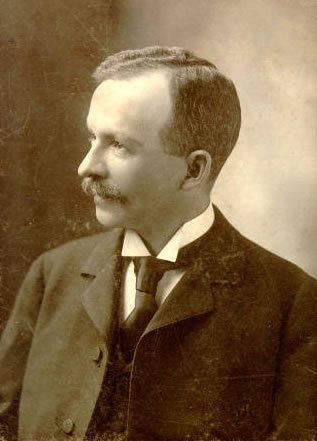37 Charles Waddell Chesnutt (1858 – 1932)
Amy Berke; Robert Bleil; and Jordan Cofer

License | Public Domain
Charles Waddell Chesnutt was born in 1858 in Cleveland, Ohio, to parents who were free African-Americans. The family moved to Fayetteville, North Carolina, when Chesnutt was a young boy, and there Chesnutt attended school, eventually becoming a teacher and later a principal. Chesnutt’s parents were mixed race, and Chesnutt himself could have identified as white but chose to identify
as African-American. After he married, he and his wife returned to Cleveland where Chesnutt passed the bar exam in 1887 and opened a court reporting firm, providing a prosperous life for his wife and four children. In Cleveland, Chesnutt began submitting his stories for publication and soon enjoyed success publishing a number of his stories in prominent literary magazines, gaining the attention of William Dean Howells, Mark Twain, and other writers in the Realist literary movement. While Chesnutt was never able to support himself and his family with earnings from his writing, he continued to write and publish through the turn of the century. Later in his life, he devoted time and energy to political activism, serving on the General Committee for the National Association for the Advancement of Colored People (NAACP), a civil rights organization formed in 1909.
Chesnutt was one of the first successful African-American writers producing fiction during the period of American Literary Realism. Chesnutt capitalized on the popularity of Local Color fiction after the Civil War and crafted stories about the Old South, depicting, for example, slaves living on plantations interacting with white plantation owners. Some of his first short stories, including the often-anthologized “The Goophered Grapevine” (1887), began appearing in literary magazines in 1887 and then were collected in The Conjure Woman (1899). In these stories about folkculture and voodoo practices in the slave community and later in the freed African-American community during Reconstruction, Chesnutt cleverly borrows the plantation tradition popular in Local Color fiction as a form which he then subverts by depicting African-American characters with innate humanity, intelligence, shrewdness, and an ability to outwit those in power. In a second collection of stories, The Wife of His Youth and Other Stories (1899), Chesnutt works with similar themes, exploring in “The Passing of Grandison,” for example, issues of “passing,” or the process by which light-skinned African-Americans could pass as whites. In this story, Chesnutt uses the term in a broader context by presenting a supposedly humble, untutored slave named Grandison whose apparent dedication to the plantation’s master, Colonel Owens, is quite possibly an act of passing; in other words, Grandison wears the mask of submission as a slave in order to trick Colonel Owens into believing that Grandison is no threat to the hierarchical order of the plantation so that eventually his planning to escape with his family goes unnoticed. As the ending of the story indicates, Grandison is, in fact, a much more dimensional, complex, determined, and daring person than the Colonel can see or even imagine.
Content Advisory
Literature involves language, descriptions, and/or topics that may be emotionally disturbing, graphic, or otherwise sensitive in nature. These topics (or materials) are important to the course as these words, attitudes, and biases are part of American literature and provide us with opportunities to better understand our history and society.
founded in 1909 by a group of prominent African-Americans, including W.E.B. Du Bois who responded to the wave of punitive laws and restrictive ordinances enacted against African-Americans after the end of Reconstruction. The founders of the NAACP opposed Booker T. Washington’s Atlanta Compromise on the grounds that it did not do enough to protect African-Americans from discriminatory laws and practices.
“Passing” is a historical term that describes the process by which light-skinned African-Americans could pass as whites.

